This original article was written to detail the process of specifically making my croissant loaf and rolls from homemade yeasted puff pastry. For the March episode of Bake it Up a Notch, we took a deep dive into all things yeasted puff, and I wanted to update the article to discuss the broader scope of this process — one of my favorite pastry doughs.
* * *
Yeasted puff pastry is one of those items on your "to-bake" list that may seem especially nerve-wracking: after all, it's a dough that combines both the difficulty of an enriched yeast-raised dough with the process of lamination, where the dough goes through a series of folds to evenly incorporate butter and achieve a beautifully layered, flaky result. But the result is truly epic: this dough produces pastries that are light as air on the inside, layered and crispy on the outside.
Yes, this process is a bit on the longer side, but I can also attest it has a number of things that deserve a check in the "pro" column. For one, there are a few options for freezing this dough, which makes it a perfect baking project that can be done when you have the time, with rewards you'll be baking up for weeks afterward (fresh baked croissants on a whim, anyone?). You can fly to Paris and follow your nose to the nearest batch of buttery perfection fresh from the oven, or you can roll up your sleeves and tackle this tasty treat at home. It's a peak worth hiking because the summit is sweet!
Ready to tackle this beauty for yourself? Here's what you need to know:
* * *
Yeasted puff pastry: How does it work?
When I did the first episode of "Bake it Up a Notch" on the classic method for puff pastry, I got lots of questions related to yeasted puff pastry. Classic puff pastry starts with a basic dough, locks a block of butter inside it, and puts it through a series of folds, which create layers in the dough. Puff pastry is typically used to make treats like Napoleons and palmiers — recipes where you want buttery flakiness and a good bit of crunch.
Yeasted puff pastry goes through a similar process as traditional puff pastry (lamination, that is), but instead uses a yeast-raised dough. Yeast-raised puff pastry is used to make pastries like croissants, danish, kouignn amann, and more. These products have a similar level of flakiness as the Napoleons and palmiers we mentioned above, but also have just the right amount of tender chewiness.
Here's how the lamination process works for yeasted puff: The dough is rolled out and a block of butter gets wrapped inside it (this is called "locking in" the butter). Then, it's rolled out again. When the dough is rolled out, the butter layer, trapped inside the dough, becomes thinner the same way the dough does. The dough is then folded, creating layers of dough and butter, and the whole rolling, locking, and folding process is repeated. Each time, the dough and butter are rolled and folded to create more layers. When the dough hits the heat of the oven, the moisture inside the butter — which is still locked inside the dough, in many thin layers — begins to evaporate and lets out steam. Combined with the yeasted dough, this steam creates the signature light, fluffy interior of a croissant with a deeply golden, shattery-crisp exterior.
As mentioned above, this is a long process, and throughout, we have to remind ourselves that the yeast is alive (!). For this reason, it's important to keep the dough chilled between steps so that the yeast doesn't rise too quickly and over-proof the dough before you're ready for it to hit the oven. Chilling also helps the dough rest and relax, keeping it easy to work with. The name of the game here is chilled but pliable; the dough should be cold enough to not be soft or sticky, but not so cold that it's stiff and unworkable.
I typically recommend spreading the project out over a few days into some manageable chunks. A sample schedule could be: Day 1: Mix the dough and refrigerate it overnight. Day 2: Laminate the dough, shape the croissants. At this point, you could proof and bake the croissants (this can be stretched to a third day with the shaped croissants resting in the fridge overnight). Alternatively, the shaped croissants can be frozen or and baked later.
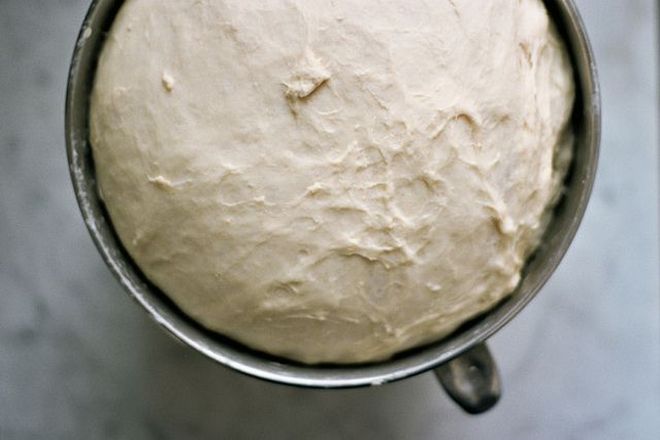
This is croissant dough. Photo by Yossy Arefi
* * *
The dough
While it is possible to make yeasted puff with all-purpose flour, I use bread flour. The higher protein content will play a crucial role in the elasticity of the dough (aka, its ability to easily be rolled out and folded several times). The dough used to make yeasted puff pastry is classified as an "enriched" dough, meaning it contains ingredients like butter, sugar and milk. The primary liquid is milk rather than water, which also helps to promote tenderness in the end result, as well as even browning of the exterior. After mixing, the dough is allowed to slowly proof in the refrigerator for a longer period of time. This produces a flavorful dough that's also easier to work with.
Here's a step-by-step of the process: Place all the ingredients in the bowl of an electric mixer fitted with the dough hook attachment. Mix on low speed for three minutes, then raise speed to medium and mix for three minutes more. Transfer the dough to a large greased bowl. Cover the bowl with plastic wrap and refrigerate for 10 to 12 hours.
If you don't have a stand mixer, this can be a trickier dough to make by hand, but it is possible. Mix the ingredients together in a large bowl with a wooden spoon, and once it comes together into a shaggy mass, turn it out onto a clean work surface and knead it until it's very smooth, 15 to 20 minutes. Then cover the bowl and refrigerate as above.
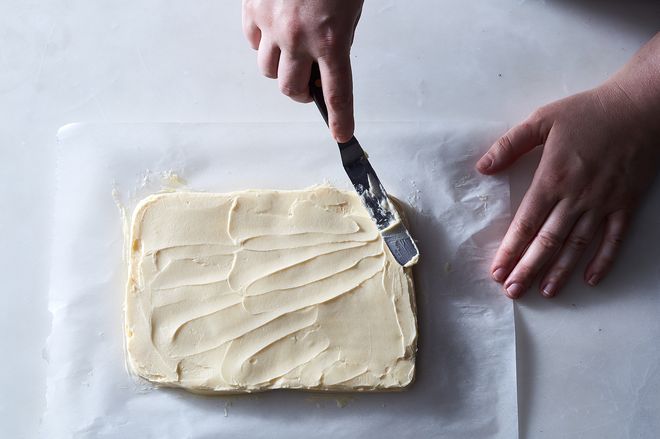
Get your butter block right. Photo by Julia Gartland
* * *
The butter block
The butter block is just what it sounds like — a big block of butter that is sealed inside the dough, and is what really makes it so flaky and wonderful. To do this, some recipes simply beat room temperature butter into a block shape and incorporate it in the dough. In pastry school, some instructors went a step further and added a little bit of bread flour to the butter block. The flour helps make the butter block more pliable, giving it a bit of structure when you roll it out and fold it. You can mix these ingredients in a mixer, or just by hand. I opt to do this in the mixer, then spread into the desired block shape and size.
Here's how you make your butter block: Cut a piece of parchment about the size of a half baking sheet (13x18 inches), and place it with one of the shorter sides facing you. Scoop the butter mixture onto the lower third of the paper, and spread it into a rectangle about 1/2-inch thick (about 6x9 inches). Try to square off the edges as much as possible. Fold the upper part of the parchment down over the butter block. Transfer the butter block to the refrigerator to chill until firm but still pliable: It should physically bend, easily, not break or shatter.) If you over-chill the butter block or make it ahead of time, let it sit at room temperature until it reaches this "firm but pliable" state before proceeding (for reference sake, the ideal temperature is around 65 to 70°F).
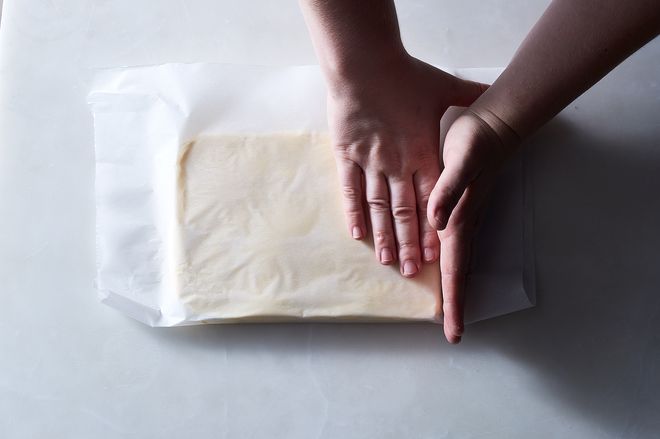
Use a hefty amount. Really. Photo by Julia Gartland
* * *
The lock-in
What we call the "lock in" happens when the butter block gets wrapped fully inside the dough. To perform this step, and all subsequent steps of the folding process, it's important that both the dough and butter are at the correct temperature. That "firm but pliable" thing I just mentioned with the butter block is exactly how you want the dough to feel, too. The idea is if the two are at the same temperature, they'll both roll out easily and stay locked in uniformly. When the dough is too cold, the dough will be harder to roll out and the butter inside might shatter, which can lead to uneven layering. If the dough is too warm, the butter mashes itself into the dough, which can eliminate the layers entirely. Once you get the feel of it, it's easy to do by sight, but if you're nervous, you can use a thermometer at the beginning to test your dough.
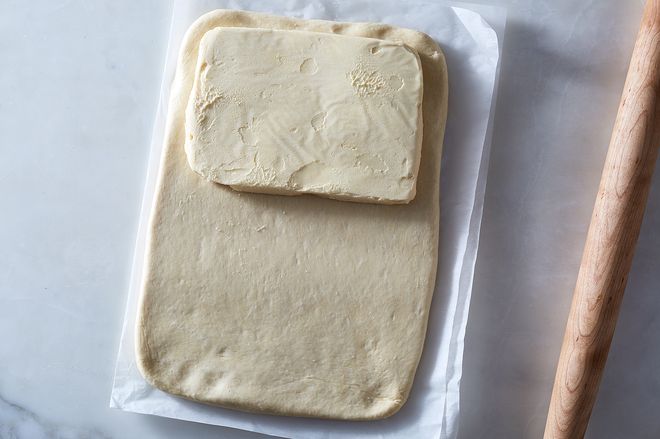
Butter on dough, chilled out. Photo by Julia Gartland
To perform the lock in, remove the dough from the fridge and roll it out on a lightly floured surface into a rectangle about 10x12 inches (and about 2/3-inch thick). Try to keep the corners squared off and the edges straight as you work — you can enlist the help of a bench scraper to do so. (Usually, the process of rolling it out will get it to just about the right temperature for the lock-in, but if it feels soft, refrigerate it for a few minutes before proceeding. With one of the shorter sides of the dough rectangle facing you, prepare to add the butter.) Peel the parchment paper away from the top of the butter block, but leave the butter on the paper; this way, you can use the paper to help you place the butter onto the dough.
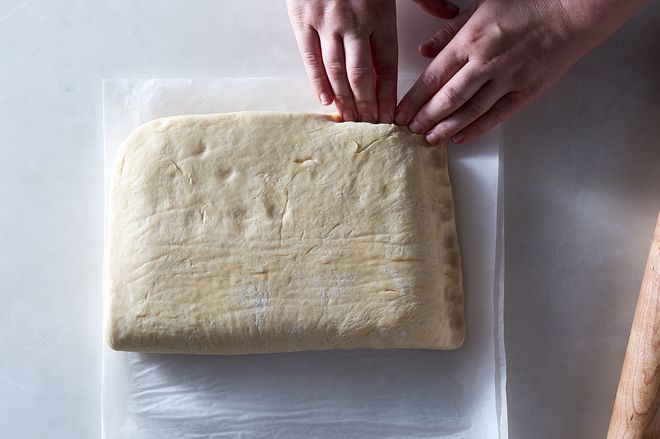
You want a safe pocket of butter. Photo by Julia Gartland
Invert the butter block (still-papered side up) onto the lower half of the dough, positioning it so that there is a 1/2- to 3/4-inch margin of dough around the sides and bottom of the butter block. Peel the paper away and discard it. Fold the top portion of the dough down over the butter block. If it isn't quite long enough in any place, gently stretch the dough with your hands until it reaches the dough on the base. Press the edges together all the way around to seal, then fold the excess dough at the bottom and edges under itself. You should now have a rectangular package of dough (about 6x10 inches). Usually, the dough is still chilled enough at this point to proceed with the first fold, but if it or the butter feels warm, wrap it tightly in plastic wrap and refrigerate for 15 to 25 minutes.
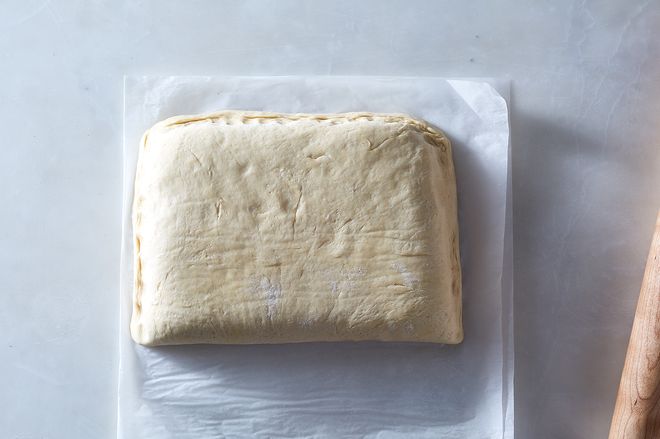
You're going to be rolling this out later. Photo by Julia Gartland
First fold
The folding is where it can get a little tricky. There are two kinds of folds, and the first is called a four fold. To make the four fold, roll out the dough on a lightly floured surface into a rectangle about the size of a half baking sheet (13x18 inches) and about 1/2-inch thick. When you're done rolling, brush any excess flour away from the surface. Now, you'll want to fold the outside edges inward, having them meet slightly off-center. The result will look a little like an open book with an off-center spine.
In other words: Fold the edge on the left toward the center, about 3/4 of the way across the dough. Fold the edge on the right, 1/4 of the way across the dough, and make sure the edges meet. (Even though it's important for the edges to meet, don't be tempted to squish them into place—the warmth of your hands combined with the pressure could muck up the formation of layers or warm up the butter.) Now fold the larger half over the shorter half (the edges should meet to make a clean rectangular shape), and transfer the dough back to a parchment-lined baking sheet. Refrigerate for 15 to 25 minutes (until firm but pliable) before starting the second fold.
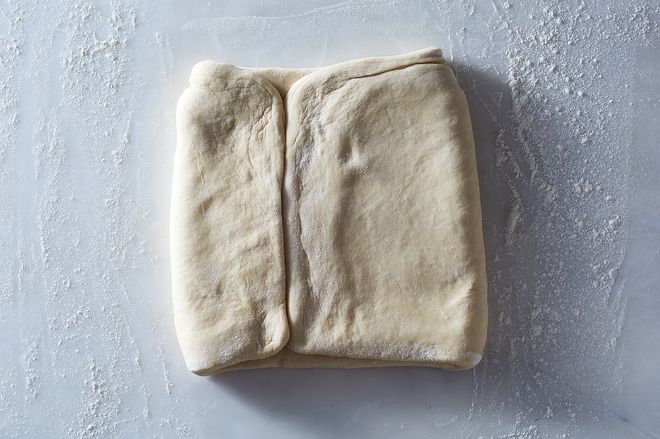
This is the start of the first fold. Photo by Julia Gartland
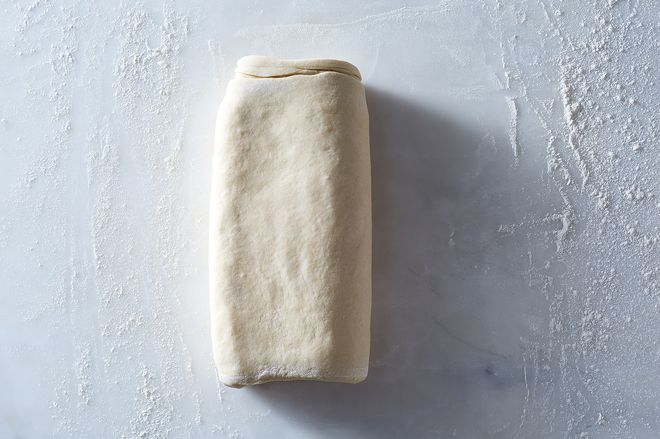
This is the end of the first fold. Photo by Julia Gartland
Second fold
The second fold is a little easier to walk through. Remove the dough from the refrigerator, lightly flour your surface, and roll the dough out again into your 1/2-inch thick rectangle that's about 13x18 inches big. Fold the one short edge 1/3 of the way over the dough. Fold the other short edge 1/3 of the way over the dough as well, resting on the piece you just folded over. Think of it like folding a piece of paper to fit into a standard size envelope. Same rules apply as they did to the first fold: Brush away excess flour, try very hard to keep the dough rectangular in shape, and try to make the ends meet up as closely as possible. Wrap the dough in plastic wrap and refrigerate for 15 to 25 minutes (until firm but pliable) before starting the next fold.
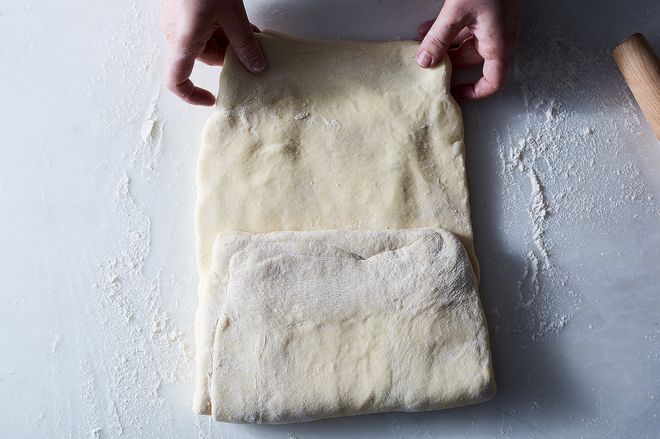
Fold it like you would a piece of paper going into a regular letter envelope. Photo by Julia Gartland
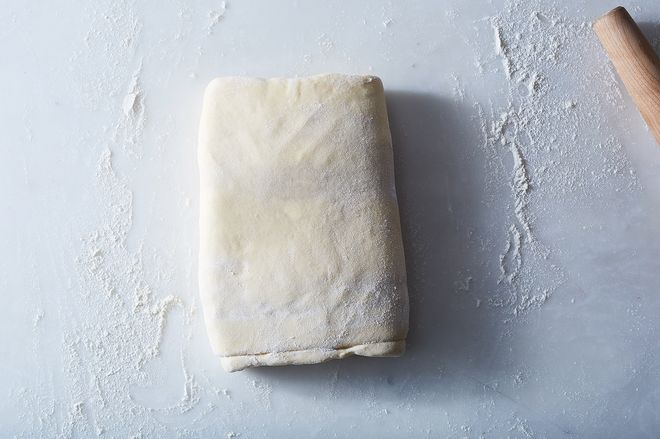
Get that rectangle. (Turn it over if you want, and admire your handiwork.) Photo by Julia Gartland
Third fold
The third fold is a repeat of the first fold, so just follow those instructions again. Sometimes, the dough is still cool enough after completing the third fold that you can proceed right onto the final fold. However, don't rush it if you think your dough has warmed up — your flaky layers will suffer the consequences. But often (mainly because you're more comfortable with the process at this point), you can work quickly enough to complete the final fold right away. Otherwise, wrap it up and chill for 15 to 25 minutes.
Fourth fold
The fourth and final fold is a repeat of the second fold, so just follow that step again. At this point, you can wrap the dough tightly and chill it for 15 to 25 minutes (or up to overnight!) before continuing with the recipe.
* * *
Rolling and shaping
Yeasted puff pastry can be rolled and shaped in a variety of different ways. It can be baked on a parchment-lined baking sheet or inside a mold to achieve a specific shape. Two important notes to keep in mind before you get started: Most recipes will have you working with only a portion of the dough at a time; use a sharp knife to divide the dough, and keep any pieces you're not working within the refrigerator. And if using a mold, lightly grease it before beginning the shaping process.
Roll out the dough on a lightly floured surface. Use only as much flour as you need to throughout the rolling process, but avoid using too much, as this can actually make the dough more difficult to roll out. Roll the dough to the desired thickness: or recipes like croissants and danish, this might be about 1/4- to 1/3-inch thick. For larger items, like a croissant loaf, it might be as much as 1/2-inch thick. Depending on the recipe, a specific dimension and shape may also be suggested to easily transition into the final pastry's form.
Shaping can be done a variety of ways — from classic and stuffed croissants to Danish galore to molded loaves and rolls. Place the pastry (seam-side down whenever possible) onto the prepared baking sheet or into the prepared mold. Molded pastries typically will not fully fill the mold before the dough rises; as it proofs, it will fill in the pan and get taller. Continue the process by working with the next piece of chilled dough until you have rolled out and shaped all your pastries.
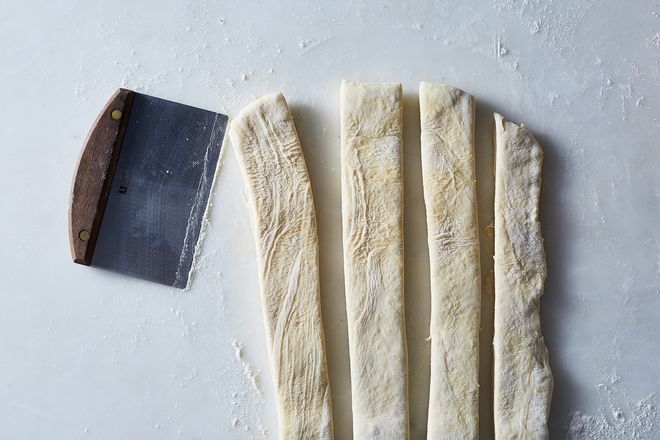
Vertical strips, ready to roll. Photo by Julia Gartland
* * *
Rising
You've come a long way. I know it's tempting to throw your perfectly shaped yeasted puff pastry nto the oven right now, but you've got a little more waiting to do. First, loosely cover the dough — this can be done with lightly greased plastic wrap (which keeps things a touch more moist) or a clean kitchen towel (which can start to dry out the surface of the baked goods slightly). Most recipes will guide you that yeast-raised puff pastries take 40 minutes to 1 hour to rise. But my best advice is to be very patient and accept that it might take even longer. As a rule, enriched doughs (like this puff, but also things like brioche or challah) take longer to rise than lean doughs (like baguettes or ciabatta). In addition, a sufficient rise can really make the difference for lofty, impressive pastries.
Under-proofed pastries will be very dense, and will lack the height and lightness of properly proofed dough. Over-proofed pastries may sort of "deflate" in the oven. Look for the dough to be noticeably puffy — the shaped pastry should nearly double in size as it proofs. When you think the dough has properly risen, press it gently with your fingertip. Properly risen dough should hold the indentation for a brief moment, then slowly start to spring back. If you're making pastries in winter, this could take a while; and conversely, if you're working in a very warm place, it may take less time.
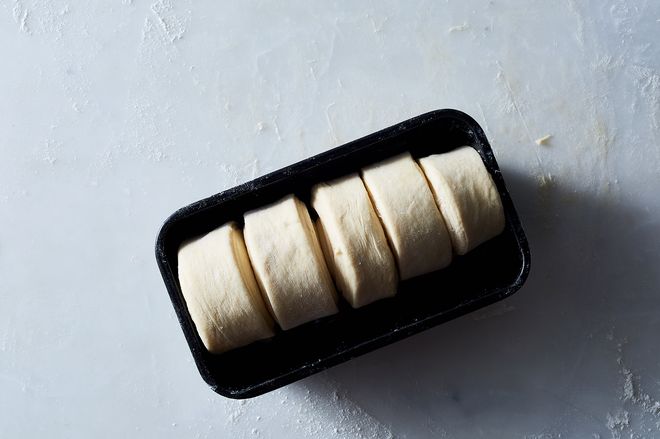
Has it risen? If not, don't bake! Photo by Julia Gartland
* * *
Baking
Yeasted puff pastry items generally bake at slightly higher temperatures to help with the initial steam release from the fat and also to achieve maximum "oven spring" (or rise) from the pastries. This can range anywhere from 350 to 400°F, depending on the pastry in question. Individual pastries, like croissants, may bake at a higher temperature. Larger pastries, like the croissant loaf, may require a lower temperature since they have a much longer bake time. Most yeast-raised pastries are egg washed for added shine and more even browning.
When the pastries are transferred to the oven, bake until deeply and evenly golden brown on the outside, and a temperature of 200°F on the inside. If the pastry is browning too much but hasn't reached the right internal temperature, tent it with foil and/or reduce the oven temperature 25 degrees for the remainder of baking. Allow pastries to cool at least 10 minutes before serving warm; larger pastries, like the croissant loaf, should cool completely before being sliced.

It's not very difficult to put this to use! Photo by Julia Gartland
* * *
Freezing yeasted puff
Since this recipe is a bit of a doozy, but worthy of special occasions, I want to recommend freezing options. You can opt to freeze one of two ways: frozen pastries before baking, or after.
To freeze unbaked, shaped pastries, place them close together (but not touching) on a parchment-lined baking sheet. Wrap the baking sheet tightly and freeze until the pastries are solid. They can be stored like this or in an airtight freezer container. To bake, transfer the desired number of pastries to a parchment-lined baking sheet as directed by the recipe. Cover with plastic wrap and let thaw in the refrigerator overnight, then proof and bake as directed. The pastries can be frozen this way for up to 6 months.
To freeze baked pastries, unmold the pastries, if necessary, and wrap them tightly in one layer of plastic wrap and one layer of foil. The pastries can be frozen this way for up to 3 months. To refresh, thaw the pastry overnight at room temperature. Once thawed, unwrap it from the plastic wrap, and rewrap it in the foil. Transfer to the oven and preheat to 375°F. Allow the pastry to stay in the oven until the preheat buzzer rings, and for 3 to 5 minutes with the oven at full temp. Remove from foil and serve.
Related recipes:


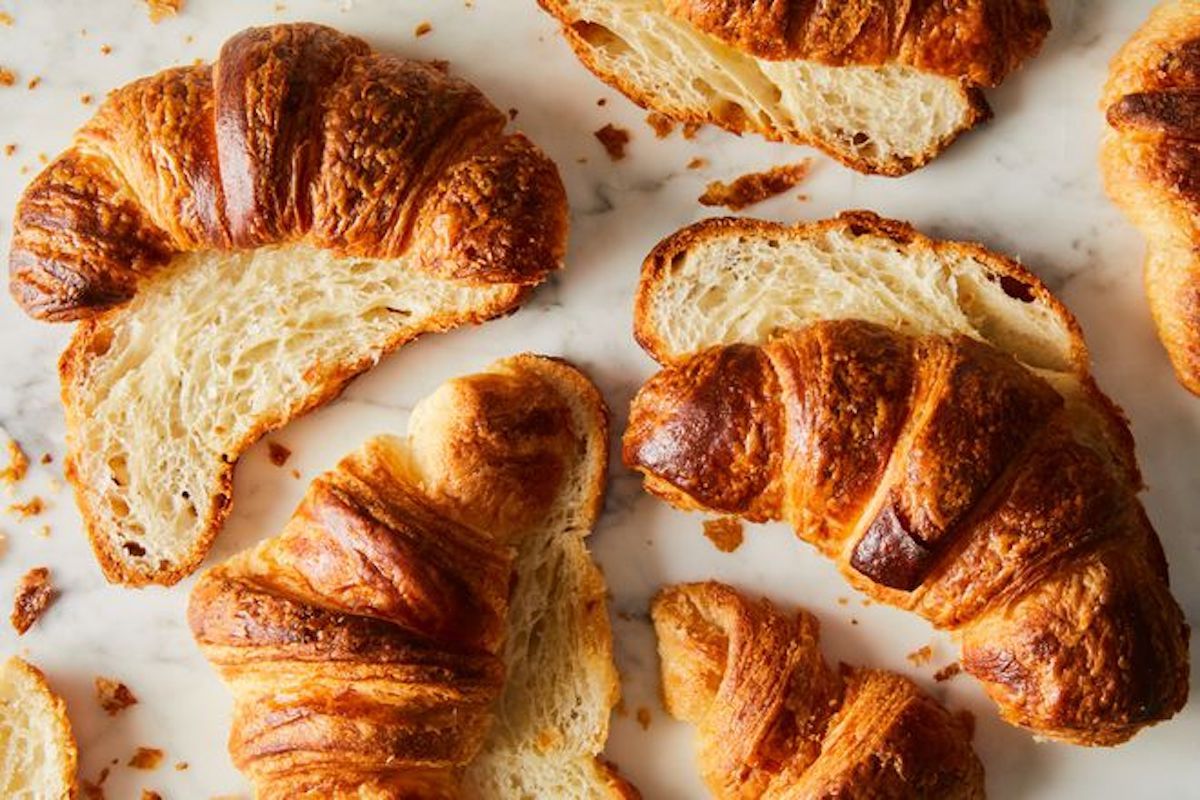

Shares